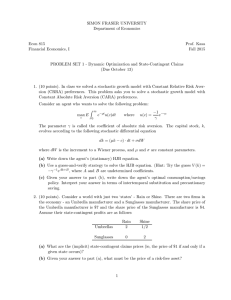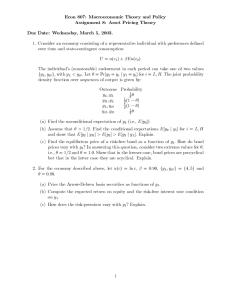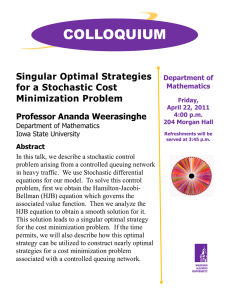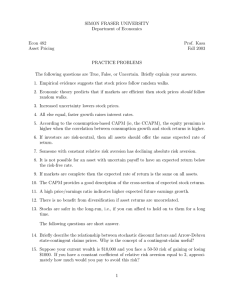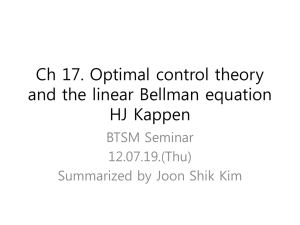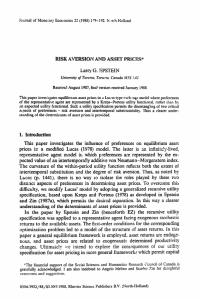SIMON FRASER UNIVERSITY Department of Economics Econ 815 Prof. Kasa
advertisement
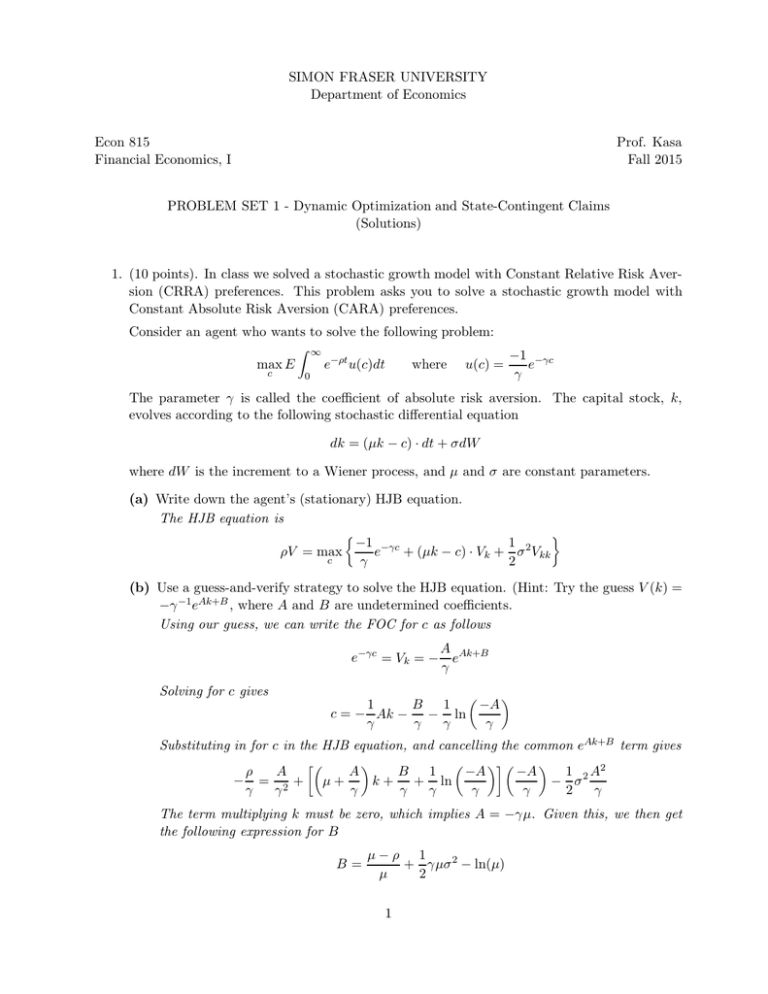
SIMON FRASER UNIVERSITY Department of Economics Econ 815 Financial Economics, I Prof. Kasa Fall 2015 PROBLEM SET 1 - Dynamic Optimization and State-Contingent Claims (Solutions) 1. (10 points). In class we solved a stochastic growth model with Constant Relative Risk Aversion (CRRA) preferences. This problem asks you to solve a stochastic growth model with Constant Absolute Risk Aversion (CARA) preferences. Consider an agent who wants to solve the following problem: max E Z c ∞ e−ρt u(c)dt where u(c) = 0 −1 −γc e γ The parameter γ is called the coefficient of absolute risk aversion. The capital stock, k, evolves according to the following stochastic differential equation dk = (µk − c) · dt + σdW where dW is the increment to a Wiener process, and µ and σ are constant parameters. (a) Write down the agent’s (stationary) HJB equation. The HJB equation is ρV = max c −1 −γc 1 + (µk − c) · Vk + σ 2Vkk e γ 2 (b) Use a guess-and-verify strategy to solve the HJB equation. (Hint: Try the guess V (k) = −γ −1eAk+B , where A and B are undetermined coefficients. Using our guess, we can write the FOC for c as follows A e−γc = Vk = − eAk+B γ Solving for c gives 1 −A B 1 c = − Ak − − ln γ γ γ γ Substituting in for c in the HJB equation, and cancelling the common eAk+B term gives ρ A − = 2+ γ γ −A A B 1 µ+ k + + ln γ γ γ γ −A γ 1 A2 − σ2 2 γ The term multiplying k must be zero, which implies A = −γµ. Given this, we then get the following expression for B B= µ−ρ 1 + γµσ 2 − ln(µ) µ 2 1 (c) Given your answer to part (b), write down the agent’s optimal consumption/savings policy. Interpret your answer in terms of intertemporal substitution and precautionary saving. Given our solutions for A and B, we can then derive the following expression for the consumption policy function c = µk + 1 1 ρ − µ − σ 2 γ 2 µ2 γµ 2 The ρ − µ term reflects intertemporal substitution, while the last term reflects precautionary saving. 2. (10 points). Consider a world with just two ‘states’ - Rain or Shine. There are two firms in the economy - an Umbrella manufacturer and a Sunglasses manufacturer. The share price of the Umbrella manufacturer is $7 and the share price of the Sunglasses manufacturer is $4. Assume their state-contingent profits are as follows: Umbrellas Rain 2 Shine 1/2 Sunglasses 0 2 (a) What are the (implicit) state-contingent claims prices (ie, the price of $1 if and only if a given state occurs)? Let Pr be the Arrow-Debreu price for rain, and let Ps be the Arrow-Debreu price for sun. From the law-of-one-price, we then get " 7 4 # = " 2 1/2 0 2 #" Pr Ps # Inverting the matrix, we find the following expression for the AD state-contingent claims prices " # " #−1 " # " # Pr 2 1/2 7 3 = = 0 2 4 2 Ps (b) Given your answer to part (a), what must be the price of a risk-free asset? A risk-free claim entitles you to a unit of consumption no matter which state occurs. To guarantee this, you must buy AD claims for both states. The price of this will just be the sum of the two AD prices: Priskf ree = Pr + Ps = 5. 2
